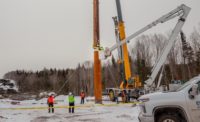

Passage of a stopgap Federal Aviation Administration extension bill through Sept. 16 has ended a congressional stalemate—at least temporarily—that had forced the agency to issue stop-work orders on more than 200 airport modernization contracts, including construction and engineering projects, estimated at more than $10.5 billion.
Although most lawmakers have left Washington for a few weeks, senators approved the extension by unanimous consent during a pro forma session on Aug. 5. President Obama signed the bill into law the same day. The bill passed the House on July 20 and includes a controversial rider that trims the Essential Air Service (EAS) program that subsidizes flights to rural airports.
While industry sources say they are relieved the hiatus, which began on July 23 and lasted for two weeks, did not extend through the recess into September, they claim the gap in funding had a significant impact and that they are not confident congressional leaders will be able to work out their differences before the Sept. 16 deadline.
Meanwhile, some firms say they are getting back to work on project sites, while others say they are waiting in a sort of limbo for official notices to proceed. “All [the extension] solved was the immediate shutdown” of the FAA, says Brian Deery, senior director of Associated General Contractors of America's Highway and Transportation Division. “There's a whole lot of uncertainty out there about projects that are moving forward.”
Bismarck, N.D.-based Knife River Corp. was awarded a $10-million taxiway resurfacing contract at Glacier International Airport in Kalispell, Mont., in the spring but still awaits funding.
“We were anticipating funding to be available in June so we could start construction in mid-June for the construction season,” says David Zinke, president of the firm's Mountain States region. “It was July 22 when we were told the project was probably going to be put on hold for the season,” he says. Now that the FAA is back to work, “we don't know where this project stands as far as the priority list—if it's going to be funded or not.”
Lost Time
In California, work is resuming at two major, federally funded projects for air-traffic-control towers in Oakland and Palm Springs. Acknowledging that the general contractors have returned to the construction sites, Ian Gregor, spokesman for the FAA's Western-Pacific region in Los Angeles, said on Aug. 7 that activity would begin as soon as the contractors can remobilize their subcontractors.
At Oakland International Airport, Devcon Construction, Milpitas, has returned to the construction site that hosted 60 workers until the shutdown, according to airport spokeswoman Rosemary Barnes. The $31-million project consists of a 236-ft-tall tower to replace two aging towers built in 1962 and 1972, respectively. In addition to the employees who were out of work for 14 days, heavy construction equipment costing $6,000 a day sat idle on the jobsite. “It had a major impact here,” Barnes says.
Tom Nolan, executive director of Palm Springs International Airport, said the construction site, with nearly 60 workers, was not fully staffed as of Aug. 7, but Swinerton Builders, San Francisco, the general contractor, was back on-site. The $13.9-million project includes a 150-ft-tall tower and a 7,200-sq-ft base building. Completion is scheduled for early 2013.
In New England, Frank Swanson, president CMGC Building Corp., Bedford, N.H., received notices on Aug. 8 to resume work on two airport projects—one in Poughkeepsie, N.Y., the other in Danbury, Conn.—and an $88,500 mechanical-room upgrade at the Boston Air Route Traffic Control Center, located in Nashua, N.H.
While this is good news for Swanson and his workers who will be back on the job, he says it does not cover losses from the 14-day disruption. CMGC lost a total of $10,000 in labor, remobilization and fixed costs for trailers and other items, he says. “We will also have to redo a railing that has been exposed to the weather—that's all lost labor,” he says.




Post a comment to this article
Report Abusive Comment